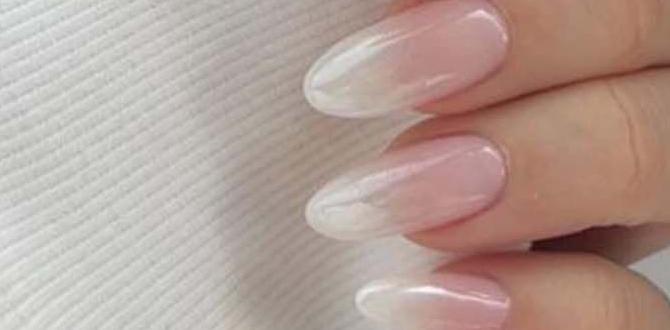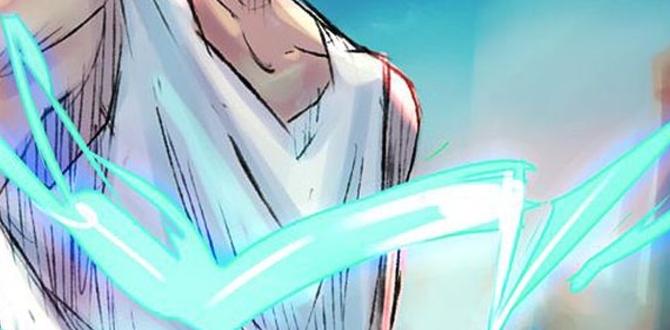Tie Dye Nail Design Tutorial: Stunning, Effortless Looks for Everyone!
Want to achieve stunning, effortless tie-dye nails? This beginner-friendly tutorial breaks down the fun and vibrant tie-dye nail design process step-by-step. You’ll learn simple techniques to create unique, swirling patterns that express your personal style. Get ready to unleash your inner artist and rock these eye-catching manicures with confidence!
Welcome, nail art lovers! Are you mesmerized by the groovy, swirling patterns of tie-dye and wish you could wear that magic on your fingertips? It’s totally understandable! Tie-dye nails look like a wearable piece of art, but many think they’re complicated to create. The good news? They’re actually super achievable, even if you’ve never done nail art before. We’re here to show you exactly how to get those beautiful, blended colors without any fuss. Ready to create some colorful magic? Let’s dive in!
Getting Started: Your Tie-Dye Nail Adventure
Kicking off a new nail art project is always exciting! For tie-dye nails, we want to set ourselves up for success. This means gathering the right tools and understanding a few basic concepts. Don’t worry, I’ve got you covered with everything you need to know to make your tie-dye nail design tutorial experience a breeze.
Essential Tools for Vibrant Nails
Having the right supplies makes all the difference. Think of these as your trusty sidekicks in the quest for amazing tie-dye nails! It’s better to have them ready before you start, so you can focus on the fun creative part.
- Base Coat: This protects your natural nails and helps polish adhere better.
- Top Coat: Seals your design and adds a beautiful shine, making your nails last longer.
- Nail Polish Colors: Grab at least 2-3 colors that look good together. Think bright, bold, or pastel – whatever your vibe!
- Dotting Tools or Toothpicks: These are perfect for creating small dots and swirling colors.
- Small Brush or Sponge: A fine-tip brush (like an old eyeliner brush) or a makeup sponge can help blend colors.
- Nail Polish Remover & Cotton Swabs: For cleaning up any smudges or mistakes.
- Optional: Clear Nail Polish: Sometimes helpful for creating a wet-look base for swirling.
Choosing Your Color Palette
The heart of tie-dye is the vibrant blend of colors! Think about what kind of vibe you’re going for.
- Classic Tie-Dye: Vibrant blues, pinks, yellows, and greens.
- Pastel Dream: Soft lavenders, baby blues, mint greens, and pale pinks.
- Sunset Vibes: Oranges, pinks, and yellows blending into each other.
- Monochromatic Magic: Different shades of the same color family (e.g., various blues).
Don’t be afraid to experiment! The beauty of tie-dye is that no two patterns are exactly alike. You can find great inspiration for color combinations on sites like ColorHexa, which offers a vast database of color schemes.
Step-by-Step Tie-Dye Nail Design Tutorial: Easy Technique
Let’s get our hands (and nails!) a little colorful. This method is designed for beginners, focusing on creating that signature swirl without needing professional skills.
Step 1: Prep Your Nails for Perfection
A good manicure always starts with proper preparation. It ensures your polish lasts and your nails look their best.
- Clean Your Nails: Make sure your nails are clean, dry, and free of any old polish. Wash your hands thoroughly.
- Shape and File: File your nails to your desired shape. Gently push back your cuticles.
- Apply Base Coat: Apply one thin layer of base coat. Let it dry completely. This is crucial for an even surface and to prevent staining.
Step 2: Lay a Neutral or Light Base
For the tie-dye colors to pop, it’s best to start with a solid, light base color. White is a popular choice because it makes colors appear brighter and more true to their shade.
- Apply 1-2 Coats: Apply one to two thin coats of a light, neutral polish like white, cream, or a very pale pastel.
- Let it Dry: Ensure this base coat is completely dry before moving on to the fun part! You can use a quick-dry topcoat or a nail fan if you’re in a hurry.
Step 3: Creating the Tie-Dye Swirls
This is where the magic happens! We’ll use a simple swirling technique that gives you that iconic tie-dye look.
- Dab on Colors: While the base coat is still wet (or add a thin layer of clear polish to make it wet again if it dried), carefully dab small dots or thin lines of your chosen tie-dye colors onto your nail. Don’t overthink placement; randomness is key! For example, if you’re using blue and pink, dab a few blue dots near one edge and a few pink dots near another.
- Gentle Swirling: Now, take your dotting tool, toothpick, or a fine brush. Gently swirl the colors together. You just need a few passes; don’t over-mix, or you’ll end up with a muddy color. Aim for distinct streaks and blends of color. The goal is to create organic-looking patterns, not to fully combine the shades.
- Repeat if Necessary: If you want more color or a more intricate pattern, you can add a few more tiny dots and swirl again very lightly.
Step 4: Clean Up and Perfection
Mistakes happen, especially when you’re learning! A little cleanup goes a long way in making your tie-dye nails look professional.
- Use a Cleanup Brush: Dip a fine-tipped brush (an old, clean makeup brush works great!) into nail polish remover. Carefully trace around the edges of your nail to remove any stray polish. This sharpens your cuticle line and makes the design look super neat.
- Be Gentle: Be careful not to wipe away your design. The goal is just to clean up the skin around the nail.
Step 5: Seal the Deal with a Top Coat
The grand finale! A good top coat is essential for protecting your artwork and giving it that glossy finish.
- Apply Generously: Apply a generous layer of your favorite top coat over the entire nail. Make sure to cap the free edge (paint a little on the tip of your nail) to prevent chipping.
- Let it Dry: Give your nails plenty of time to dry completely. A good top coat can take a few minutes to fully cure, so be patient!
And voilà! You’ve just created your own stunning, effortless tie-dye nail design. Give yourself a round of applause!
Alternative Tie-Dye Nail Techniques for Different Looks
While the dab-and-swirl method is fantastic for beginners, there are other ways to achieve a tie-dye effect. These variations can offer different textures and patterns, allowing for even more creative expression.
The Sponge Technique for a Blended Effect
This method excels at creating a soft, blended, watercolor-like tie-dye look. It’s great for a more subtle, diffused pattern.
Tools Needed:
- Base coat
- Light color polish (white or pale) for the base
- 2-3 tie-dye colors
- Makeup sponge (a clean kitchen sponge cut into small pieces works too!)
- Top coat
- Nail polish remover and cleanup brush
Steps:
- Prep and apply your light base color as usual. Let it dry completely.
- Apply a thin layer of clear polish or topcoat onto the nail to act as a sticky surface for the colors.
- On a piece of foil or a palette, dab small amounts of your tie-dye colors next to each other.
- Lightly dab the makeup sponge into the colors.
- Gently dab the sponge onto your nail, pressing lightly to transfer the colors. You want to see the colors blend slightly where they touch.
- Repeat the dabbing with the sponge as needed, picking up more color from the palette, until you achieve your desired coverage and blended effect. Work quickly while the clear polish is still wet.
- Once you’re happy with the blend, clean up the edges with your cleanup brush and nail polish remover.
- Apply a generous layer of top coat to seal the design and add shine.
Pros of the Sponge Technique:
- Creates a soft, diffused, and blended look.
- Excellent for achieving watercolor-like effects.
- Can be very forgiving with color placement.
Cons of the Sponge Technique:
- Can be a bit messier than the dotting tool method.
- May require more practice to get the pressure right.
- The pattern might be less defined than with sharper swirling.
The Brush Drag Technique for Striking Patterns
This technique is fantastic for creating more defined, streakier tie-dye patterns. It allows for more control over the direction of your swirls.
Tools Needed:
- Base coat
- Light color polish (white or pale) for the base
- 2-3 tie-dye colors
- A fine-tipped nail art brush (or a stiff detail brush)
- Top coat
- Nail polish remover and cleanup brush
Steps:
- Prepare your nails and apply your light base coat. Let it dry completely.
- Apply a thin layer of clear polish or topcoat to the nail to keep it moist.
- Using your nail art brush, pick up a small amount of one color and dab it onto the nail.
- Immediately pick up a small amount of another color with the same brush (or a clean one) and dab it next to or over the first color.
- Now, using the brush, gently drag the colors through each other in a swirling motion. Don’t over-blend! Just a few passes are needed to create streaks.
- Repeat with any additional colors, continuing to drag and swirl them gently.
- Clean up your edges meticulously with polish remover and a cleanup brush.
- Apply a generous top coat and let it dry.
Pros of the Brush Drag Technique:
- Allows for more control over pattern and swirl direction.
- Creates bolder, more defined lines within the tie-dye design.
- Can achieve a dynamic, streaky look.
Cons of the Brush Drag Technique:
- Requires a steady hand and some practice with brush control.
- Over-blending can quickly turn colors muddy.
- Can be trickier to achieve a perfectly even blend.
Tie-Dye Nail Design Troubleshooting Tips from Nailerguy
Even the most experienced nail artists run into little hiccups. Don’t get discouraged if your first attempt isn’t salon-perfect! Here are some common issues and how to fix them.
Issue: Colors look muddy and blended together.
Solution: You might be swirling too much or using too many colors too close together. Try using only two or three colors at a time and make very few, gentle swirling motions. Also, ensure your base polish is just wet enough – not too runny, not too dry. Applying colors in distinct dots or thin lines before swirling can help.
Issue: Polish is drying too fast, making swirling impossible.
Solution: This is common, especially in dry environments or if you’re using quick-dry polishes. Keep a bottle of clear polish handy. Apply a thin layer of clear polish over your base color just before you start dabbing your tie-dye colors. This will keep the surface wet and workable for longer.
Issue: My swirls are too distinct and don’t blend enough.
Solution: For a softer blend, try the sponge technique or use a slightly larger brush for swirling. Gently press and roll the sponge over the dabs of color, or use a more sweeping motion with your brush. You can also try applying a bit more pressure, but very carefully!
Issue: The tie-dye pattern is uneven or lopsided.
Solution: Don’t aim for perfect symmetry! Tie-dye is meant to be organic and unique. If one nail looks different from another, that’s part of the charm. However, if you’re unhappy with the overall balance, try applying a slightly darker or lighter shade of one of your existing colors in a few strategic spots and gently swirl again to add dimension.
Issue: Polish is getting all over my cuticles and skin.
Solution: This is where your cleanup brush and nail polish remover come to the rescue! Be sure to use them after you’ve finished your design and applied your colors but before the top coat. Dip your brush in remover, wipe off the excess on a paper towel, and carefully trace around your nail edge. For future applications, you can also try applying a liquid latex or a balm around your cuticles before starting. This creates a barrier that you can peel off easily once your design is done.
How to Care for Your Tie-Dye Nails
You’ve put in the effort to create these gorgeous tie-dye nails, so you’ll want them to last! Proper care will keep them looking fresh and vibrant.
- Avoid Harsh Chemicals: When doing chores like washing dishes or cleaning, always wear rubber gloves. Household cleaners and detergents can break down nail polish, causing it to chip or lose its shine.
- Moisturize Regularly: Keep your hands and nails hydrated! Use cuticle oil and hand lotion daily. Healthy nails are less prone to breaking and chipping.
- Be Gentle: Try not to use your nails as tools. Avoid picking, scraping, or prying with your fingertips.
- Touch-Up as Needed: If you notice a tiny chip or wear on the edges, you can try to carefully touch it up with a matching polish and a fine brush, followed by a thin layer of top coat.
- Reapply Top Coat: After about 3-5 days, applying an extra layer of top coat can refresh the shine and add another layer of protection, helping to extend the life of your manicure.
Frequently Asked Questions About Tie-Dye Nails
Q: Is it hard to do tie-dye nails at home?
A: Not at all! The techniques we’ve shared are designed to be beginner-friendly. With a few simple tools and some colorful polish, anyone can achieve beautiful tie-dye effects.
Q: What are the best base colors for tie-dye nails?
A: White is a fantastic choice because it makes bright colors pop and prevents them from looking too dark. Cream, light grey, or even a very pale pastel can also work well depending on the colors you plan to use for your tie-dye design.
Q: How long do tie-dye nails usually last?
A: With a good base and top coat and proper aftercare, your tie-dye nails can last anywhere from 5 to 10 days, similar to a regular manicure. Reapplying top coat every few days can help them last even longer.
Q: Can I use regular nail polish or do I need special products?
A:



